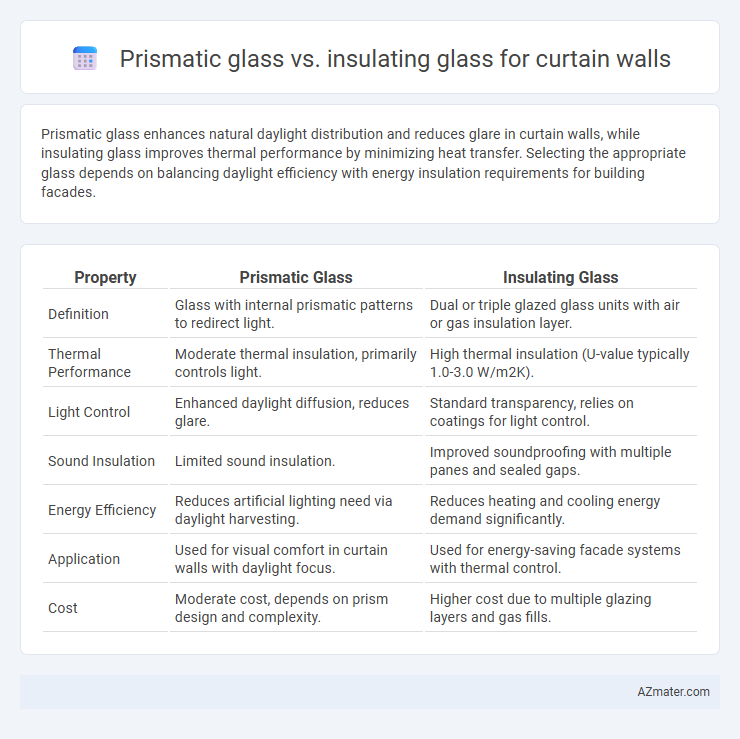Prismatic glass enhances natural daylight distribution and reduces glare in curtain walls, while insulating glass improves thermal performance by minimizing heat transfer. Selecting the appropriate glass depends on balancing daylight efficiency with energy insulation requirements for building facades.
Table of Comparison
| Property | Prismatic Glass | Insulating Glass |
|---|---|---|
| Definition | Glass with internal prismatic patterns to redirect light. | Dual or triple glazed glass units with air or gas insulation layer. |
| Thermal Performance | Moderate thermal insulation, primarily controls light. | High thermal insulation (U-value typically 1.0-3.0 W/m2K). |
| Light Control | Enhanced daylight diffusion, reduces glare. | Standard transparency, relies on coatings for light control. |
| Sound Insulation | Limited sound insulation. | Improved soundproofing with multiple panes and sealed gaps. |
| Energy Efficiency | Reduces artificial lighting need via daylight harvesting. | Reduces heating and cooling energy demand significantly. |
| Application | Used for visual comfort in curtain walls with daylight focus. | Used for energy-saving facade systems with thermal control. |
| Cost | Moderate cost, depends on prism design and complexity. | Higher cost due to multiple glazing layers and gas fills. |
Introduction to Curtain Wall Glazing Options
Prismatic glass enhances daylight distribution and reduces glare through its textured surface, making it ideal for energy-efficient curtain walls. Insulating glass consists of multiple panels separated by a spacer, providing superior thermal insulation and soundproofing benefits. Both glazing options improve building performance, but prismatic glass emphasizes light control while insulating glass focuses on thermal efficiency.
What is Prismatic Glass?
Prismatic glass incorporates a series of tiny prisms on its surface that manipulate light, enhancing daylight penetration while reducing glare and improving energy efficiency within curtain wall systems. Unlike insulating glass, which primarily provides thermal insulation through multiple glass layers separated by inert gas, prismatic glass focuses on optical performance by redirecting sunlight. This innovative glazing solution optimizes natural illumination in commercial buildings, contributing to occupant comfort and reduced reliance on artificial lighting.
What is Insulating Glass?
Insulating glass, commonly used in curtain wall systems, consists of two or more glass panes separated by a sealed air or gas-filled space to reduce heat transfer and improve energy efficiency. This type of glazing significantly enhances thermal insulation, sound attenuation, and condensation resistance compared to single-pane or prismatic glass. Insulating glass units (IGUs) are essential for meeting building energy codes and optimizing indoor comfort in commercial and high-rise buildings.
Key Differences between Prismatic and Insulating Glass
Prismatic glass features textured surfaces that refract light to enhance natural daylight distribution, while insulating glass consists of multiple panes separated by a gas-filled space to improve thermal performance. Prismatic glass mainly targets visual comfort and glare reduction, whereas insulating glass prioritizes energy efficiency and thermal insulation in curtain wall applications. The choice between prismatic and insulating glass depends on balancing daylight management with energy savings in building facade design.
Energy Efficiency: Prismatic Glass vs Insulating Glass
Prismatic glass enhances energy efficiency in curtain walls by directing daylight deeper into the building while reducing glare, which lowers reliance on artificial lighting and HVAC load. Insulating glass improves thermal performance through multiple panes with gas fills and low-emissivity coatings, significantly reducing heat transfer and maintaining indoor temperature stability. Together, these glazing options optimize energy consumption by balancing natural light management and thermal insulation.
Daylighting and Visual Comfort Comparison
Prismatic glass enhances daylighting in curtain walls by redirecting natural light deeper into interior spaces, reducing glare while improving uniformity and visual comfort. Insulating glass primarily focuses on thermal performance but may allow less daylight penetration due to its typical multi-pane design, which can limit luminous transmittance compared to prismatic options. Choosing prismatic glass can optimize natural light distribution and occupant comfort, whereas insulating glass prioritizes energy efficiency with moderate daylighting benefits.
Thermal Performance Considerations
Prismatic glass enhances daylight control and reduces solar heat gain through its micro-structured surface, improving thermal comfort in curtain wall systems. Insulating glass units (IGUs) consist of multiple glass panes separated by air or gas-filled spaces, significantly reducing heat transfer and improving energy efficiency. Choosing between prismatic and insulating glass depends on balancing solar heat gain management with overall thermal insulation requirements for optimal curtain wall performance.
Acoustic Insulation: Strengths and Weaknesses
Prismatic glass in curtain walls offers moderate acoustic insulation by diffusing sound waves, reducing noise transmission primarily through its geometric surface structure. Insulating glass, typically a double or triple-pane system filled with inert gas and sealed tightly, provides superior soundproofing by creating an air barrier that significantly dampens external noise. While prismatic glass excels visually with light modulation, insulating glass outperforms in acoustic insulation due to its multilayer construction and airtight sealing.
Aesthetic Impact on Curtain Wall Design
Prismatic glass enhances curtain wall design by creating dynamic light refraction, producing vibrant visual effects that change throughout the day and add depth to building facades. Insulating glass prioritizes thermal performance and transparency, offering a clean, sleek appearance that maximizes natural light while maintaining energy efficiency. The choice between prismatic and insulating glass significantly influences the aesthetic impact, with prismatic glass providing artistic, light-responsive facades and insulating glass delivering minimalist, modern visuals.
Best Applications and Recommendations
Prismatic glass is ideal for curtain walls in commercial buildings requiring enhanced daylight control and glare reduction, optimizing natural light distribution while minimizing energy costs. Insulating glass excels in energy efficiency and thermal performance for curtain wall systems in climates with extreme temperature variations, providing superior insulation and reducing HVAC loads. For projects prioritizing daylight management and occupant comfort, prismatic glass is recommended, whereas insulating glass suits applications demanding stringent energy codes and thermal regulation.

Infographic: Prismatic glass vs Insulating glass for Curtain wall
 azmater.com
azmater.com